Sandhills Farming in Nebraska
Mississippi River Basin
|
NEW ESRI StoryMaps: What's On Our Shelves & NWNL Song Library & No Water No Life ESRI |
Mississippi River Basin
Bruce Switzer
Rancher & Conservationist
Alison M. Jones
NWNL Director & Photographer
Carolyn Bowman
NWNL Guest, Author and Traveler
All images © Alison M. Jones, unless otherwise noted. All rights reserved.
Bruce Switzer is a third-generation owner of land offered as a free patent by Nebraska’s Kinkaid Act (1904). The Kinkaid doubled earlier Homestead Act (1862) allotments of “non-irrigable” land west of the 98th meridian. A land rush followed.
Many turned back at the first soft yellow chophills, pockmarked by blowouts and warted with soapweeds. Others kept on, through this protective border, into the broad valley region, with high hills reaching towards the whitish sky.
–Sandoz, Mari (1935). Old Jules. Lincoln: University of Nebraska Press. p. 268.
Families like the Switzers persevered in Nebraska by living in underground homes called “soddies” as they struggled through the 1930’s Dust Bowl. Today Bruce “rents his grass” half the year to other ranchers for grazing their cattle. The rest of the year he buys cows, breeds and feeds them well, finally selling them as hamburger for school lunches and nursing homes.
A Sandhills rancher’s number of cattle are limited by his wells, which are also limited. Thus, ranchers are always seeking more property to obtain more water. In eastern Nebraska’s sandy, arid land, wells tap down deep for nonrenewable fossil water from the Ogallala Aquifer.
Today, Bruce’s 12,000-acre ranch is part of the Gracie Creek Landowners Association. As well the Switzer Family offers room and board for visitors wishing to witness mating prairie chickens and sharp-tailed grouse or a taste of Nebraska farm life. The benefits of conservation and tourism help compensate for his ranching losses after the damming of Calumus Lake significantly reduced his water supply.
It is fitting that NWNL post this article now (2019), as this is the 70th anniversary of the farming revolution in the US and beyond!

NWNL Bruce, thank you for your hearty welcome to your family ranch. There is much to see and learn here. Let’s start with how you provide water for livestock on this arid, sandy land?
BRUCE SWITZER We have three solar windmills with well pumps that cost $4,000 to $6,000, depending on the depth; and it costs $500 to $1,000 to rebuild the windmills, when they wear out. They utilize a brass cylinder with leather cups to bring up the water. If the wind doesn’t blow, we use submersible pumps.
I personally rue the day that wind turbines come to these sandhills.
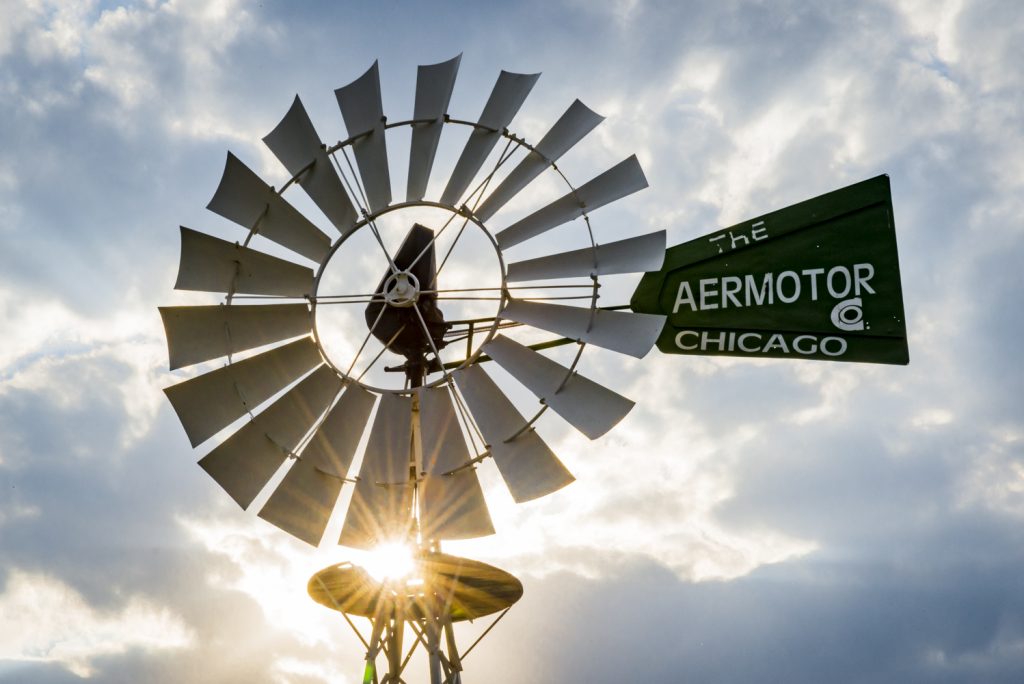
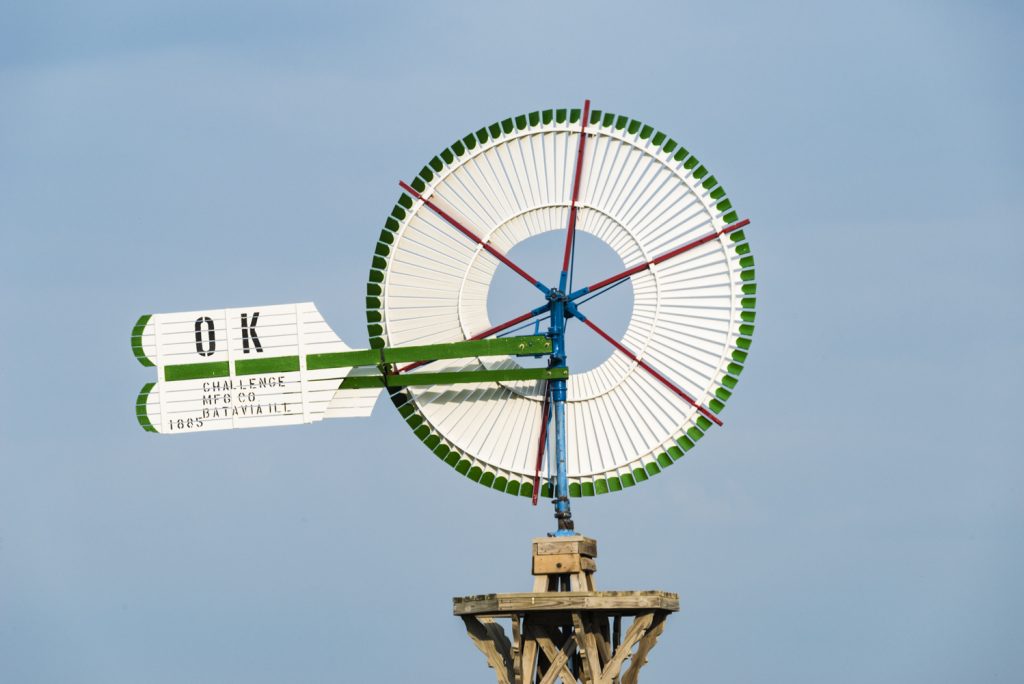
Antique windmills!
BRUCE SWITZER A farmer raised in Nebraska, Frank Zybach, invented center-pivot irrigation [an overhead, circular sprinkler system] in 1949. This allowed many farmers to water more efficiently, especially in the sandy soil we have. Now with today’s technology, satellite images of a field can show which parts of a field are sandier than another part. With that information, a satellite-connected, pivot-irrigation system can automatically put more water on that area. Then when the pivot gets to better ground, it will automatically cut back on water emitted.
That same technology can also help corn planters now simultaneously sow different hybrid corns. When a farmer has hybrids that do better in certain soils, he plugs in that information and the appropriate varieties of hybrid seeds. The farm’s satellite system then automatically directs the connected planter to plant specific hybrids in specific soil types.
These systems have really done a lot to conserve water. But there are places in the Platte Valley down south where fields are shaped such that you can’t run a pivot. There they run water down the field. That type of flood irrigation takes 40% more water than running water through a pivot system.
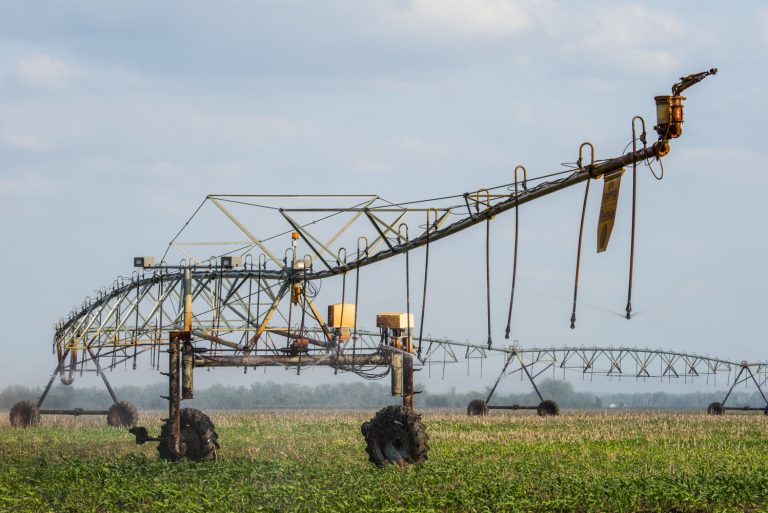
NWNL That’s not intuitive, because I have watched pivots spew water into the air, and thus much evaporates before it reaches the soil.
BRUCE SWITZER But pivots don’t do that anymore. They drop the water down, and so there’s very little evaporation anymore.
My question is, if a landowner is going to use 40% more water on a little triangle field, then why not plant that field back to grass and put cows on it, instead of water or corn? Or at least plant something on such a field that requires less water than corn. For some people, it doesn’t make a damn bit of difference whether they raise corn or raise beans. There are dry edible beans now that take very little bit of water.
NWNL Do you mean garbanzos? Farmers plant garbanzos frequently in the arid, sandy Palouse region of eastern Washington. There most farmers don’t till, because they have the same type of hills you do here, their sand having been blown in from the Cascade Mountains.
BRUCE SWITZER Yes, they plant dry beans in western Nebraska too, because there’s no rainfall, and the aquifer out there isn’t as deep. The reason you can’t do that here is because folks say, “It isn’t corn.” I’d just like to slap them. I hope nobody’s farmers here in this room!
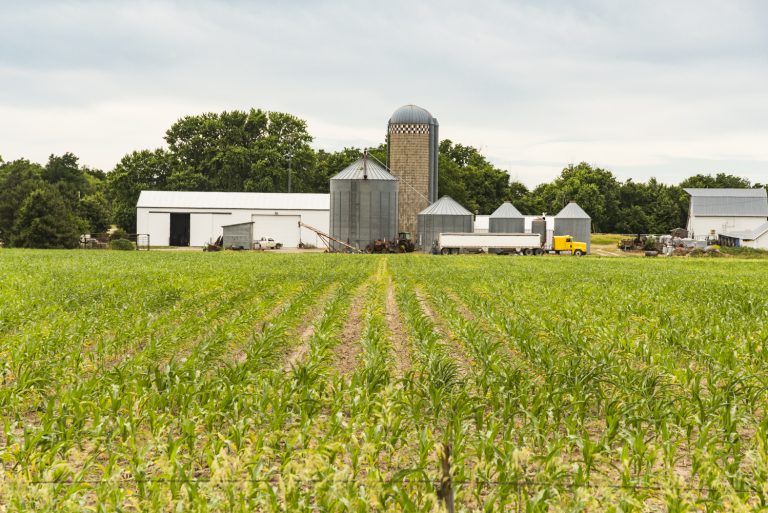
NWNL Bruce, in other words you’re saying that corn is the local identity for farmers in eastern Nebraska?
BRUCE SWITZER Yes, but I think the next generation is smarter. They will figure out a more efficient usage of water. At least I hope they do, but I don’t know how they’re going to make water out of nothing. Why in the hell… when we’ve already used up so much water…., why in the hell do we want to wait until there’s a problem before we start thinking about doing something about it? Let’s start thinking about conserving it before we have to. When it’s gone, it’s gone.
NWNL Are there farmers here who choose to leave their lands unplowed, or untilled, in order to preserve healthy soil structure and water retention?
BRUCE SWITZER Yes, and here the “no-till” practice really helps.
NWNL In 1985, the US Bureau of Reclamation completed the nearby earthen dam impounding your local Calamus River for irrigation storage and flood control. That created a large 5,124-acre reservoir. What were the impacts of that government project?
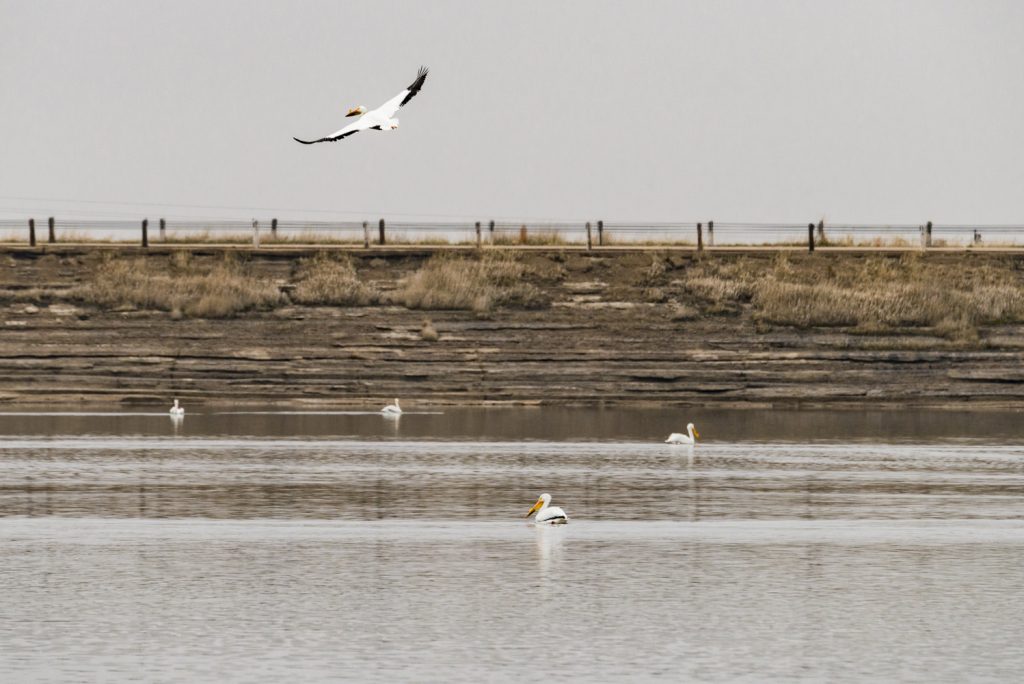
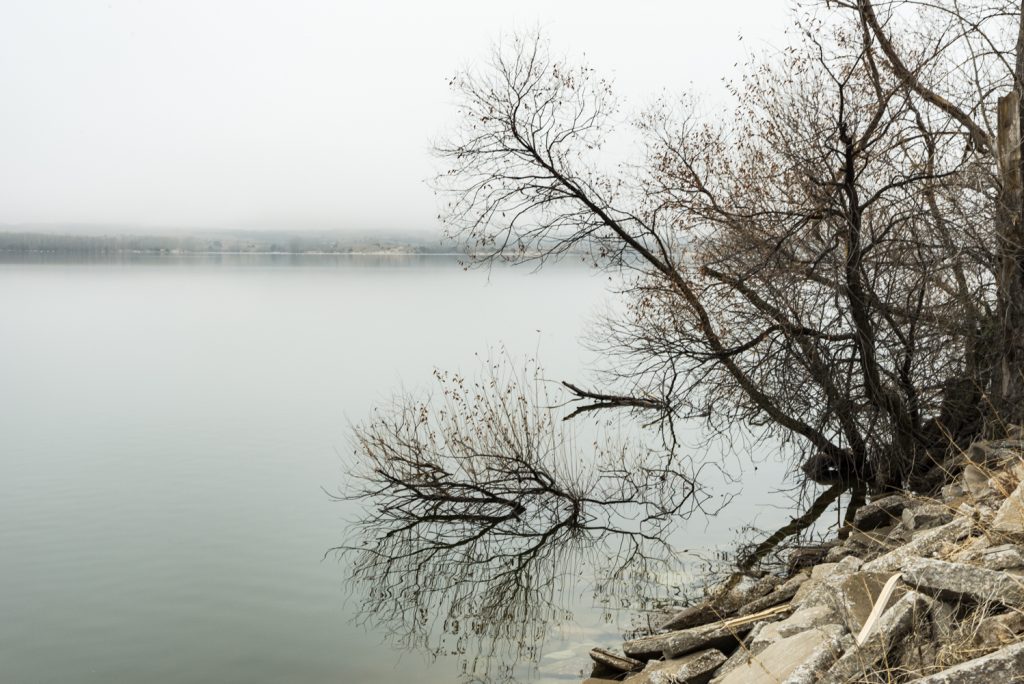
Calamus Reservoir, created by the earthen Virginia Smith Dam, is vacationers’ destination as it offers a beach in Nebraska!
BRUCE SWITZER One impact is the increase in invasive species brought in by vacation folks from Omaha, Lincoln and other places. White-tailed deer fled to the hills as they lost their valley and they chased out most of the mule deer. White-tailed deer begin to have offspring at 1 year, but the mule deer don’t begin until age 2; and the white-tail are more likely to have twins, or even triplets. So they multiply much faster.
Ranchers and farmers suffered because they lost a valley long used for growing hay as winter feed. The land was taken over by the principle of “Eminent Domain.” [ED Note: “Eminent Domain” is also at the core of the current resistance by Nebraska farmers against Canada building the Keystone XL oil pipeline across their fields.]
While it was proposed that Lake Calamus was for irrigation, the Switzer Ranch is not allowed to take out any water, even though the state took over much of our land.
The lake has become a stop-over habitat for migrating white pelicans and dozens of bald eagles. It is now mainly used for recreation, especially fishing. [ED Note: Reservoir species include: walleye, wiper, white bass, northern pike, largemouth bass, rainbow trout, and crappie and others.]
Calamus State Recreation and Wildlife Management Areas provide migratory habitat for white pelicans, hooded mergansers and many other species.
NWNL Bruce, to save this farm for your family and protect the unique beauty and ecosystems of the Sandhills, you’ve adopted conservation and tourism. We came here to learn how the simple, but fascinating, prairie chicken makes it possible for you to keep an ecosystem healthy while also continuing as a successful rancher and farmer!
BRUCE SWITZER The prairie chicken is “our bird.” It doesn’t go anywhere else. It’s our responsibility.
NWNL That bird turned you into a conservationist?
BRUCE SWITZER Well, as a rancher, it is all about grass. Thus, ranchers are conservationists. We met representatives from World Wildlife Fund(WWF) through a mutual friend. We held them “suspect” at first, but found they have the same goals as we do as ranchers. Now, The Nature Conservancy has an easement for part of the ranch.
We have 12,000 acres where we run about 750 cattle. We also have 25 leks. Leks are communal areas in which two or more males of a species perform courtship displays for prairie chicken and short-tailed grouse. Additionally, two creeks run through the ranch. WWF provided hydrologists and biologists who gave us great information. They explained why we have had no willows by the creeks and have never had beavers or bear. We used to have a lot of ring-necked pheasants, when there was access to lots of water — before the Calamus Lake Reservoir was dammed. But the pheasants took over prairie chicken nests. Now we’ve corrected that problem.
Another problem was that after the Dust Bowl, we planted native red cedars as windbreaks to save our soil. But now they have become problematic, invasive species throughout our ranches. We know not what we do!
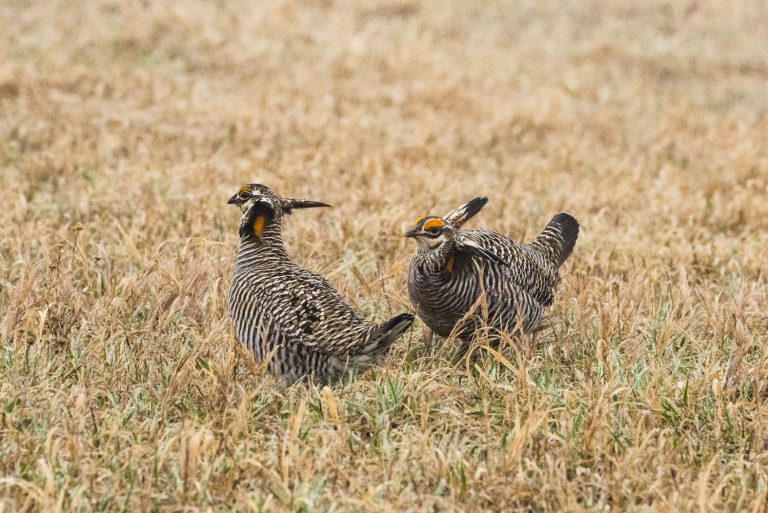
NWNL Another quote for your book: “We know not what we do!”
BRUCE SWITZER We still need and are creating windbreaks, but now we use only sterile red cedars. We’ve also learned to plant legumes, such as peanuts, to restore nitrogen in this sandy soil. The experts gave us data on our 18 mating leks for the prairie chickens and short-tailed grouse. Every April since 2010, we have done an annual count. In another 6 years we expect to see a clearer pattern of these grassland ground birds, their behaviors and their numbers on our land.
Already, we have learned our grassland birds, such as the prairie chickens and short-tailed grouse, won’t go within 100 yards of a tree because they know it can serve as a perch for their many predators, including owls, eagles, northern harrier, coyote, racoons, skunks and possums.
We keep learning more…. If a female grassland bird is bred on a lek, she will nest within 1-2 miles of that lek. Learning all that, we now carefully plan where to set our burns and eradicate trees. We have lots of land and thus can burn sections for 10 years without burning any patch twice. That’s significant because we now know they need dense patches of thickets as protection from hailstorms and snakes.
NWNL Bruce, you have a great story, full of family values, ranching solutions and Sandhills stewardship. Congratulations for what you have done – seemingly always framed with a good sense of humor!
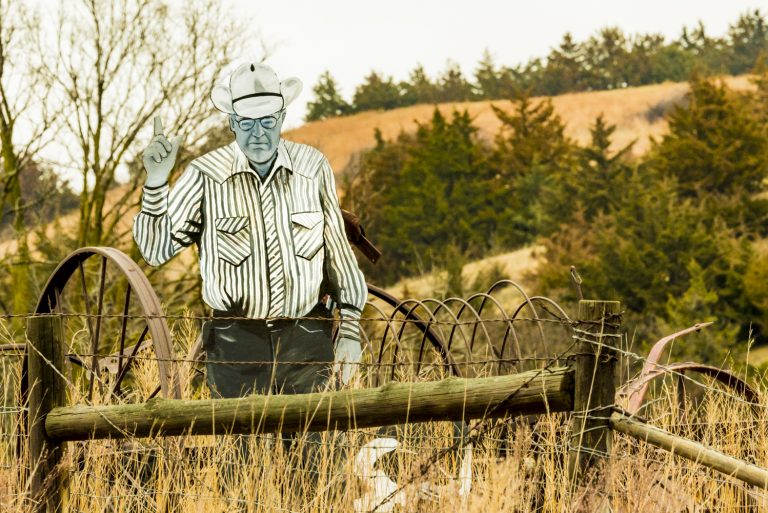
Posted by NWNL on October 16, 2019.
Transcription edited and condensed for clarity by Alison M. Jones.
All images © Alison M. Jones, unless otherwise noted. All rights reserved.
